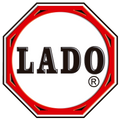What is there that a child likes more than playing with their parents or an adult? Put these games into practice and you will be helping them develop their logic, differentiation and classification skills.
There are endless games that can be made with logic blocks and even more so with LADO Logic Blocks (Ref 226) that provide more attributes to go deeper into classifications, series and logic games.
And why logic blocks are the best for this? They are the best because they are simple pieces that only differ from each other by 1,2, 3, 4 or 5 attributes, they do not have more differences, nor commercial additions as if they have the rest of the toys, and this allows the child to perfectly describe without confusion all the similarities and differences of two or more pieces.
In this table I present them to you:

Now I give you some ideas for you to play with yours.
The first thing you should know is that logic blocks, like any element in the world, have absolute and other relative characteristics/attributes, what does this mean, it means that a logic block is red because there is no doubt that that is its color, but its size will be big or small depending on what we compare it with, that is, COLOR is an absolute attribute while SIZE is relative.
Based on this, our games should start with the Absolute Characteristics/Attributes that the child understands more easily. That is why we will play games about COLOR, SHAPE and TEXTURE.
1. ACTIVITIES (for children 3-4 years old):
First you prepare the field of play. We are going to play with the big jar of LADO Ref 226 (with 120 pieces).
Take all the Big Chunky Blocks in 4 colors and 5 shapes out of the pot and put the rest of the pot away.
Of these we will start first playing only with 3 colors and 3 shapes (square, circle and triangle). Once you have them separated, the question game begins:
- Relating it to everyday objects, tell him: Give me a Block of the same color as the ball. What color is it? Now give me another one of the same color as the tablecloth... (So on)
- Separate me the Red blocks (and successively with the rest of the colors)
- Separate the Squares from the rest of the shapes.
- Make a perfect tower with the circles. Put the rest of the shapes in a tower as well.
Once you have mastered these 3 colors and shapes, gradually add the last color you have left and the rectangular and hexagonal shape and continue doing exercises...
- Take a rectangular block and review its shape with a pencil on a sheet of paper. How is it different from the square?
- Put any block vertically on the ground, try to put another similar block on top so that they can stand on their own. Which ones can you put a block on top of vertically and which ones you can't? Because? What happens to the circle and the triangle?
- Have you noticed that the blocks are not the same on one side as on the other? What's wrong with them? Put all the blocks with the rough side up.
- Separate me the following block: Triangle, Blue on the smooth side. (Combining the color, shape and texture you can ask for infinite combinations)
- One of the two hides a block and the other must find out which block is missing by looking at the ones left on the table.
2. MORE ADVANCED ACTIVITIES (for 5-year-olds):
Once you have mastered these characteristics we can begin to introduce the relative characteristics/attributes.
We start with the SIZES and for this we take all the small Blocks and put them together with the previous ones (keep in mind that in our large jar Ref 226 we work 3 sizes, start by taking the smallest thick blocks so that the child can clearly see the difference between the large block he has worked on so far and the smallest one you are going to present to him, and leave the medium ones in the pot.)
Now we will have all the same blocks in big and small size. We continue to do the same type of exercises but now we are also asking about the size.
Once mastered, we introduce the medium blocks. We'll let him look at them, compare, tell him to stack the same shaped blocks by size, etc.
- We will ask you to take a square of each size and go over it with a pencil on a sheet of paper.
- Then we started to make games like the previous ones but also asking for medium pieces. Ex: Separate me the Triangle, Small, Green by the rough side.
3. Next we introduce the last relative attribute which is the THICKNESS . So far we have been working with the thick blocks. Now we will use absolutely all the blocks in the boat and we will ask you to differentiate between a thick block and a thin one.
- Why is this block thinner than this other?
- Separate me all the fine blocks.
- Give me all the thin squares you find.
- Separate me the following block: eg Hexagon, Small, Red, Fine and on the smooth side.
4. Once you master these games and know how to answer you without hesitation, we can start working with the Attribute cards and the Double Entry Tables . You'll see how fun. When you have it, go to the following post:
Games with Attributes for Logic Blocks and Double Entry tables.
Finally I leave you an example of real exercises that he does in the cabbages with the Logical Blocks LADO...
http://laclasedemiren.blogspot.com.es/2017/06/juegos-de-logica-matematica-describimos.html
http://laclasedemiren.blogspot.com.es/2015/04/juegos-de-logica-matematica.html


Leave a comment